Beijing Temple of Heaven: Ancient Imperial Altar of Sacrifice to Heaven and Earth
The Temple of Heaven Park in Beijing was originally built during the Ming Dynasty (1420 AD) and is located in the Dongcheng District. It served as the site for emperors of the Ming and Qing dynasties to perform sacrifices to heaven, covering an area of approximately 2.73 million square meters. Designed in the architectural style of “heavenly round and earthly square,” it is one of the five major altars in Beijing, situated about 10 kilometers from the Earth Altar. Declared a UNESCO World Cultural Heritage Site in 1998, it is now a 5A-level tourist attraction in China.
The Temple of Heaven has four main gates—east, south, west, and north—and an additional small gate on the western side. According to legend, this smaller gate was specially built by Emperor Qianlong as a shortcut for his personal use. Emperor Qianlong established a regulation that Emperor Qianlong established a regulation that Emperors older than 70 could use this gate. Unfortunately, no emperor after Qianlong lived past 70. Consequently, this gate was only used by Emperor Qianlong alone.
Historical Context
The Temple of Heaven was first constructed during the reign of the Ming Dynasty’s Emperor Yongle (1420 AD), modeled after the layout of the Temple of Heaven in Nanjing. Originally named the “Altar of Heaven and Earth,” it featured a dedicated structure called the Grand Sacrificial Hall for the joint worship of the deities of Heaven and Earth.
In 1530 (the ninth year of the Jiajing era under Emperor Jiajing), the Ming emperor ruled that the combined worship of Heaven and Earth at the “Altar of Heaven and Earth” was inappropriate. So, he built an earthen altar about 10 kilometers away as a dedicated place to worship the land god.
By 1534 (the thirteenth year of Jiajing), the “Altar of Heaven and Earth” was renamed the Temple of Heaven, and a new Circular Mound Altar was constructed to the south of the Grand Sacrificial Hall for the exclusive worship of the Heaven deity.
In 1538 (the seventeenth year of Jiajing), the Grand Sacrificial Hall was demolished, and construction began on the Great Hall of Enjoyment at the same site. Completed in 1544, this structure was renamed the Hall of Prayer for Good Harvests, used to pray for bountiful agricultural harvests.
1889: The Hall of Prayer for Good Harvests was destroyed by a lightning strike.
1890: Reconstruction of the Hall of Prayer for Good Harvests began.
1896: Reconstruction was completed.
In 1912, with the demise of the Qing government and the establishment of the Republic of China, the Temple of Heaven was handed over to the Beiyang government for administration.
Architectural and Scenic Highlights of the Temple of Heaven
Hall of Prayer for Good Harvests (Qiniandian)
A large circular hall with a diameter of approximately 32 meters and a height of about 38.2 meters (source: Beijing Temple of Heaven official website). It was used to pray for a good crop.. According to ancient Chinese measurements, its height is 9 zhang 9 chi 9 cun 9 fen (1 zhang ≈ 3.33 meters), symbolizing the nine layers of heaven. Inside, the hall is supported by 28 pillars. The innermost four pillars represent the four seasons (spring, summer, autumn, winter). The middle 12 pillars symbolize the 12 months of the year. The outer 12 pillars represent the 12 double-hours (each double-hour ≈ 2 hours) in one day.
Circular Mound Altar (Huanqiutan)
The core structure of the Temple of Heaven, used for sacrifices to the deity of Heaven on the winter solstice. The altar stands 5.7 meters high and consists of three tiers. The topmost tier is paved with 3,402 segmented stones arranged in concentric circles.
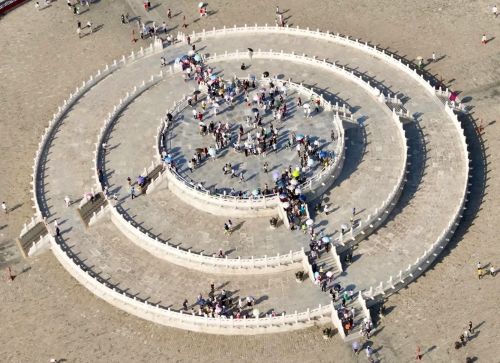
Imperial Vault of Heaven (Huangqiongyu)
The Hall of the Supreme Heaven (Huangqiongyu) is a sacred space where spirit tablets of deities and imperial ancestors are stored. During ritual ceremonies, these spirit tablets are ceremoniously retrieved for worship and returned to their original place after the ceremonies conclude. The spirit tablets enshrine the following: the Supreme Deity, Solar Deity, Stellar Deity, Deities of Wind, Rain, Thunder, and Lightning, as well as the eight emperors of the Qing Dynasty.
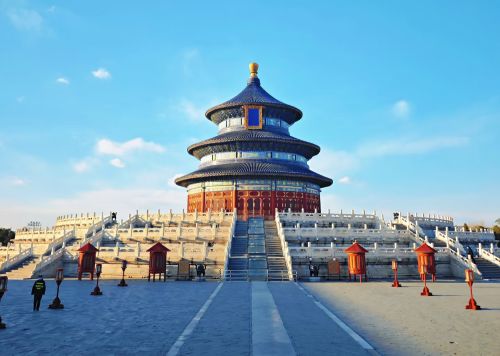
Seven Star Stones (Qixing Shi)
Seven large stones located northeast of the Hall of Prayer for Good Harvests, symbolizing seven major mountains. Legend has it that the area originally appeared too open and lacked “good feng shui,” so the emperor placed the stones to stabilize the energy (feng shui) of the site.
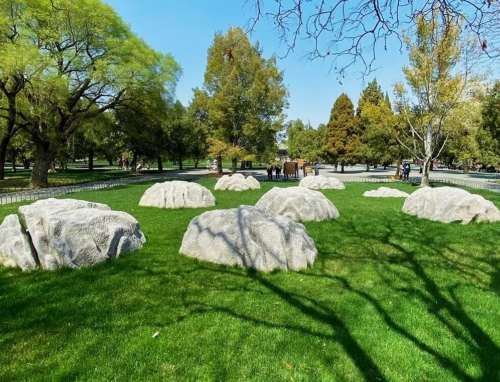
Zhaigong
Before rituals, emperors would reside here for three days of fasting to show respect to the deities. However, Emperor Yongzheng found this practice too arduous (preferring the comfort of the imperial palace) and reduced the fasting period to one day before ceremonies.
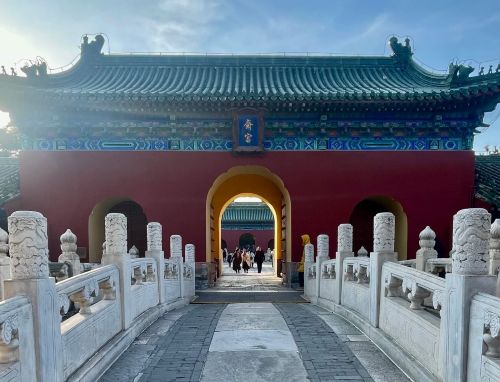
Yuelv Bureau (Shenlebu)
During the Ming and Qing dynasties, this was a venue for rehearsing ritual music and dance. Today, it has been converted into a museum displaying ancient musical instruments and ceremonial attire.
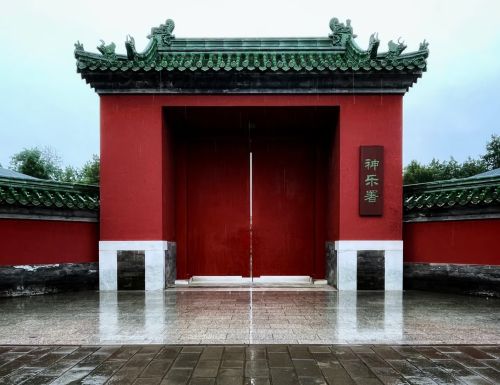
Month Rose Garden (Yuejiyuan)
This garden is filled with rose plants, which bloom beautifully in spring.
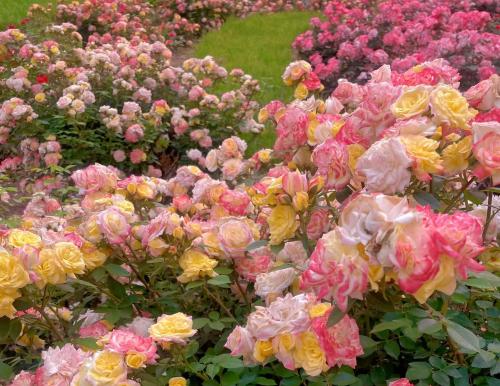
Four Seasons Garden (Baihuayuan)
A landscaped area that remains vibrant year-round, featuring a diverse collection of plants and flowers.
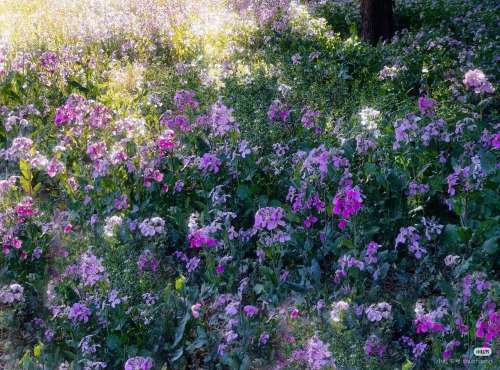
Nine Dragon Cypress (Jiulongbai)
A 600-year-old cypress tree with a height of about 11.5 meters and a trunk diameter of 1.2 meters. Its bark is deeply wrinkled, giving it a distinctive appearance.
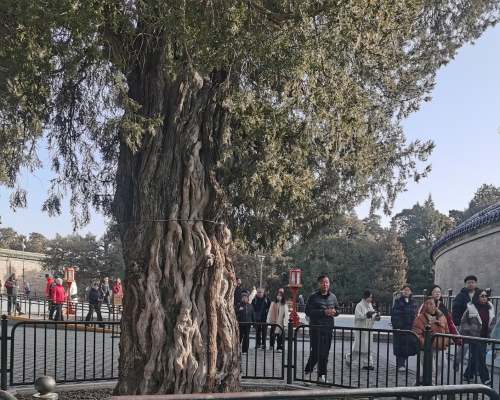
Cultural Activities
Lantern displays are held in the Temple of Heaven Park during the Lantern Festival, which is full of festive atmosphere.
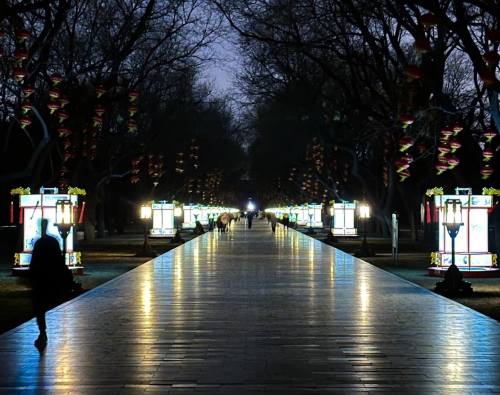
Ticket Prices
Basic Admission Fee: 15 CNY, grants access to the Tiantan Park for free attractions only.
Full Ticket Price: 34 CNY, allows entry to major paid attractions within the Tiantan Park (additional charges may apply for specific sites).
Note: Ticket prices vary between the low season (off-season) and peak season.Low Season: November 1 to March 31 of the following year.Peak Season: April 1 to October 31.
Opening Hours
- Peak Season (April 1 – October 31): 6:00 AM – 10:00 PM (Major attractions open from 8:00 AM – 5:30 PM).
- Off-Season (November 1 – March 31 of the following year): 6:00 AM – 9:00 PM (Major attractions open from 8:00 AM – 4:30 PM).
Transportation
- Subway Line 5: Exit and walk for 5 minutes to reach the east gate of Tiantan Park.
- Subway Line 8: Exit and walk for 10 minutes to reach the west gate of Tiantan Park.
Suggested Tour Route
- Entering through the East Gate or West Gate, you can stroll through the Temple of Heaven in about 3 hours.
- After exiting through the west gate, you can return to Subway Line 8 and reach Qianmen Station in just two stops, making it very convenient.
Tips & Recommendations
- If time permits, visit in the evening to enjoy the beautiful night scenery.
- Ice cream in the shape of a prayer hall ($28 a piece) is not recommended.
- Avoid Driving: We advise against driving due to limited parking spaces and high parking fees near the park.
If you want to know more about the Beijing Temple of Heaven, please visit its official website. Have a nice trip!